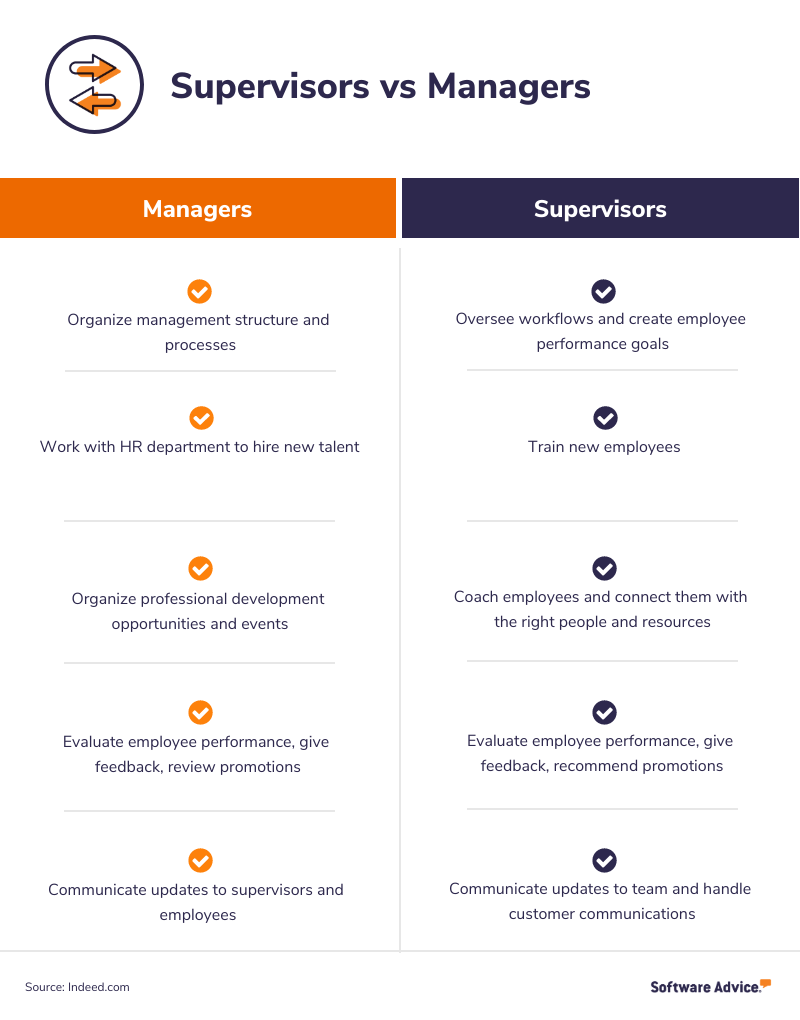Supervisors vs Managers: Learn Their Similarities and Differences to Figure Out Which You Need
Without supervisors and managers, teams and business processes would fall apart. Both play critical roles in your business’ ecosystem, and it’s important to know which you need and when to set your teams up for success.
Although these titles are sometimes used interchangeably, there are key differences between supervisors and managers, including level of authority, responsibilities, goals, and pay. Here’s a breakdown of common responsibilities for supervisor and manager roles:

Supervisors vs managers: 5 differences you need to understand
1. Managers develop processes, while supervisors carry them out
Managers are typically responsible for organizing your company’s structure, workflows, and processes. Supervisors then take these processes and ensure their teams know their role in that process.
Supervisors may act as a team leader, setting performance goals for employees and ensuring certain metrics and expectations critical to business priorities are met.
Both supervisors and managers may use the same software but in different ways. For example, managers may use business management software, project management software, and workflow software to monitor processes as a whole, while supervisors may use these platforms for monitoring individual employee contributions.
2. Managers hire employees, while supervisors train them
While managers may work closely with human resources to interview and hire new employees, supervisors will likely be the ones to train them, help acquaint them with their new responsibilities, and make sure they understand the company’s culture and code of conduct.
Once employees are hired, managers may spend less time with new hires than supervisors, depending on the company, its size, and its leadership structure.
Additional reading:
3. Supervisors coach team members individually, while managers provide overall professional development resources
Continuous coaching and improvement are cornerstones across industries as businesses recognize the value of investing in employee development (full research available to Gartner clients).
Both managers and supervisors contribute to employee professional development, and their exact role in this process depends on how the business’ management structure is set up.
Supervisors might take on more of a coaching role by helping employees work through specific goals and connecting them with the right people while managers support employees by organizing networking events, webinars, or larger professional development workshops.
Additional reading:
4. Supervisors handle external-facing communications, while managers focus on internal communications
Supervisors and managers alike must possess strong interpersonal skills and be excellent communicators, but who they communicate with may differ.
Those in a managerial position often handle more internal-facing communications. For example, upper management may communicate updates to middle management, who then pass them on to supervisors, depending on the company’s chain of command and organizational structure.
Supervisors are then responsible for communicating the information to their smaller teams and to those outside of the organization who need to know, such as clients or customers.
No matter the structure at your business, it’s important that supervisors and managers communicate with each other to ensure a mutual understanding of business processes and goals.
5. Supervisors and managers both evaluate employee performance and give feedback
Monitoring employee performance and giving (and receiving) feedback are important for businesses that value continuous improvement. These responsibilities are typically shared between managers and supervisors.
Depending on your organization, managers could set overall goals for teams while supervisors work with individual members to set performance goals that will lead to collaborative success.
Since supervisors may work more closely with employees on a daily basis, they will likely evaluate employee performance and share it with their managers. These performance reports may also include promotion recommendations, which will require approval from someone at the management level.
Additional reading:
Managers and supervisors support business processes and teams in different ways
The relationship between supervisors and managers is, ultimately, symbiotic, each supporting the other and the business’ primary goals.
Although supervisors and managers share similar job functions, differences rest in the number of processes and people they manage. As a result, managers are typically paid more than supervisors, since they are usually responsible for more processes and larger teams.
When you’re looking to hire leaders for your business, consider the differences between a supervisor and managers, and the role they would play in your unique company structure and culture,
No matter which you need or hire first, be sure your managers and supervisors are equipped with the right software to manage their teams and business processes. Talk to a software advisor today to find the right tool.